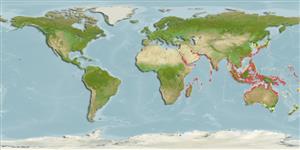Environment: milieu / climate zone / depth range / distribution range
Ökologie
seewasser; brackwasser; tiefenbereich 0 - 10 m (Ref. 86942). Tropical
Indo-West Pacific: tropical waters.
Size / Gewicht / Alter
Maturity: Lm ? range ? - ? cm
Max length : 61.0 cm TL Männchen/unbestimmt; (Ref. 117080); common length : 30.0 cm FL Männchen/unbestimmt; (Ref. 3287)
Rückenflossenstacheln (insgesamt) : 9; Rückenflossenweichstrahlen (insgesamt) : 23 - 27; Afterflossenstacheln: 3; Afterflossenweichstrahlen: 20 - 23.
Adults are common in shallow coastal waters where it often swims near the surface. They form dense schools on clear inner reefs, swimming high above substrate (Ref. 48635). They feed chiefly on shrimps, copepods, decapods and small fishes (Ref. 30573, 90102).
Life cycle and mating behavior
Geschlechtsreife | Fortpflanzung | Ablaichen | Eier | Fecundity | Larven
Paxton, J.R., D.F. Hoese, G.R. Allen and J.E. Hanley, 1989. Pisces. Petromyzontidae to Carangidae. Zoological Catalogue of Australia, Vol. 7. Australian Government Publishing Service, Canberra, 665 p. (Ref. 7300)
IUCN Rote Liste Status (Ref. 130435: Version 2024-1)
Bedrohung für Menschen
Harmless
Nutzung durch Menschen
Fischereien: weniger kommerziell
Tools
Zusatzinformationen
Download XML
Internet Quellen
Estimates based on models
Preferred temperature (Ref.
123201): 23.8 - 29.2, mean 28.5 °C (based on 2765 cells).
Phylogenetic diversity index (Ref.
82804): PD
50 = 0.5312 [Uniqueness, from 0.5 = low to 2.0 = high].
Bayesian length-weight: a=0.01148 (0.00721 - 0.01828), b=2.90 (2.77 - 3.03), in cm total length, based on LWR estimates for this species & (Sub)family-body (Ref.
93245).
Trophic level (Ref.
69278): 3.7 ±0.55 se; based on food items.
Widerstandsfähigkeit (Ref.
120179): mittel, Verdopplung der Population dauert 1,4 - 4,4 Jahre. (Preliminary K or Fecundity.).
Fishing Vulnerability (Ref.
59153): Moderate vulnerability (44 of 100).
Nutrients (Ref.
124155): Calcium = 146 [81, 356] mg/100g; Iron = 1.6 [0.9, 3.1] mg/100g; Protein = 19.6 [18.4, 20.9] %; Omega3 = 0.232 [0.126, 0.448] g/100g; Selenium = 29.1 [14.4, 61.8] μg/100g; VitaminA = 16.4 [4.7, 49.0] μg/100g; Zinc = 1.34 [0.94, 1.93] mg/100g (wet weight);
